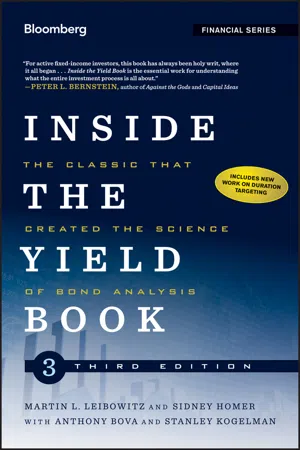![]()
Part I
Duration Targeting: A New Look at Bond Portfolios (2013 Edition)
![]()
Introduction
The standard approach to the analysis of prospective returns and risks of any portfolio combines some estimate of expected returns with a measure of interim volatility. For bonds, volatility is approximated by the product of the yield volatility and the duration. The yield move (and corresponding return) in any one period usually is presumed to be statistically independent of previous yield moves.
At first, the standard return/risk approach appears to provide a reasonable basis for projecting multiperiod returns and risks. However, with duration-targeted (DT) portfolios, where the same duration is maintained over time, returns converge back toward the initial yield, so the multiyear volatility turns out to be far less than that suggested by the initial duration. Perhaps surprisingly, this convergence and volatility reduction holds regardless of whether yields have high volatility or exhibit a steady rising or falling trend over the investment horizon.
This theoretical “gravitational pull” toward the initial yield was examined in terms of the actual returns of the Barclays index as well as to the returns of a hypothetical 10-year laddered portfolio. Both portfolios have durations in the five-year range. Our theoretical model of DT suggests that annualized returns for five-year duration portfolios should approach the initial yield in six to nine years. A historical analysis covering the period from 1977 to 2011 showed that such convergence does indeed occur.
Accrual Offsets of Price Effects
The DT rebalancing process will result in capital gains or losses, depending on whether yields have fallen or risen during the time between rebalancing. After rebalancing, the bond portfolio will reflect current market yields and will be positioned to capture the new prevailing yields as going-forward accruals. Such accruals always act in the opposite direction of price changes and, at least partially, offset duration-based price effects.
The importance of accruals is largely underappreciated because portfolio risk and return are usually analyzed in the context of relatively short holding periods. Accruals become significant over longer holding periods when accruals can build and ultimately dominate price effects.
In order to see how accruals and price effects interact, we start with simple trendline paths to terminal yields. Later we consider more general non-trendline paths.
Trendline Model
At the outset, we assume a multiyear investment horizon and a corresponding hypothetical terminal yield distribution.
From the myriad of paths to any terminal yield, we initially focus on a simple trendline (TL) along which yields change by the same amount each year. The simplicity of this idealized TL model enables us to derive a compact formula for the DT returns of zero coupon bonds. This TL return depends only on the initial yield, the duration target, the horizon, and the terminal yield. Because there is only one TL path to each terminal yield, there is a one-to-one correspondence between terminal yields and TL returns.
The TL model returns are based on a linear pricing model that is reasonably accurate for moderate yield changes. Because all DT rebalancing transactions involve the same duration and the same yield change, the annual price effects are always equal. In contrast to the constant pace of TL price changes, the importance of annual accruals accelerates over time. For example, the first-year accrual is equal to the initial yield, the second-year accrual is the initial yield plus the first-year yield change, the third-year accrual is the second-year accrual plus the second-year yield change, and so on. These accruals accumulate at rate that is roughly proportional to the square of the investment horizon.
The Effective Maturity
Because accruals along TL paths grow (or decline) at a faster rate than price changes, there is an effective maturity point at which the cumulative accruals will fully offset the cumulative price losses (or gains). This effective maturity turns out to be approximately twice the targeted duration.
If the investment horizon is less than the effective maturity, the total price effect will be greater than the total accrual effect. At the effective maturity, the net price/accrual effect will be zero. Consequently, the annualized return to the effective maturity will equal the initial yield for every TL path, regardless of whether the terminal yield is higher or lower than the initial yield. This “gravitational pull” forces all such TL returns back to the initial yield level.
Terminal Yield Distributions
We now turn to the case where a terminal probability distribution is specified. One simple example is scenario analysis in which estimates/forecasts of future yields are projected based on a range of expectations. Each yield forecast may be assigned a distinct probability weight and the weighted average of future yields can be viewed as the expected yield. Each projected yield can then be paired with a corresponding TL return and an expected return can be computed using the same weights as for the yield projections.
More generally, the standard deviation of TL returns can also be found by applying the TL return formula to the standard deviation of the terminal yields. As the horizon approaches the effective maturity, the expected TL return will converge on the starting yield—no matter how much the expected terminal yield may differ from the starting yield. The standard deviation of TL returns will then also compress down to zero, no matter how wide the standard deviation of terminal yields.
Non-Trendline Paths
The DT model can be extended beyond TL paths to the full range of pathways generated by random walks. As an example, cons...
